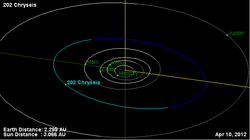Astronomy:202 Chryseïs
From HandWiki
Short description: Main-belt asteroid
 Orbital diagram | |
| Discovery | |
|---|---|
| Discovered by | C. H. F. Peters |
| Discovery date | 11 September 1879 |
| Designations | |
| (202) Chryseïs | |
| Pronunciation | /kraɪˈsiːɪs/[1] |
| Named after | Chryseis |
| A879 RA, A901 TA 1935 BL | |
| Minor planet category | Main belt |
| Orbital characteristics[2] | |
| Epoch 31 July 2016 (JD 2457600.5) | |
| Uncertainty parameter 0 | |
| Observation arc | 136.57 yr (49881 d) |
| |{{{apsis}}}|helion}} | 3.3859 astronomical unit|AU (506.52 Gm) |
| |{{{apsis}}}|helion}} | 2.7567 AU (412.40 Gm) |
| 3.0713 AU (459.46 Gm) | |
| Eccentricity | 0.10244 |
| Orbital period | 5.38 yr (1966.0 d) |
| Average Orbital speed | 16.99 km/s |
| Mean anomaly | 11.1527° |
| Mean motion | 0° 10m 59.196s / day |
| Inclination | 8.8535° |
| Longitude of ascending node | 136.848° |
| 1.3159° | |
| Physical characteristics | |
| Dimensions | 86.15±2.4 km |
| Rotation period | 23.670 h (0.9863 d)[2] 23.670 ± 0.001 h[3] |
| Geometric albedo | 0.2562±0.015 |
| S | |
| Absolute magnitude (H) | 7.42 |
Chryseïs (minor planet designation: 202 Chryseïs) is a large, lightly coloured Main belt asteroid that is probably composed of silicate rocks. It was discovered by C. H. F. Peters on September 11, 1879, in Clinton, New York, and was named after the mythical Trojan woman Chryseis.
The rotation period for this asteroid is close to a day long, so the construction of a complete light curve requires photometric observations from multiple locations at widely spaced latitudes. This task was completed in January and February, 2011, yielding a synodic rotation period of 23.670 ± 0.001 h, with a brightness variation of 0.20 ± 0.02 in magnitude[3]
References
- ↑ Noah Webster (1884) A Practical Dictionary of the English Language
- ↑ 2.0 2.1 "202 Chryseis". JPL Small-Body Database. NASA/Jet Propulsion Laboratory. https://ssd.jpl.nasa.gov/sbdb.cgi?sstr=202;cad=1.
- ↑ 3.0 3.1 Stephens, Robert D. et al. (October 2011), "The Lightcurve for 202 Chryseis", The Minor Planet Bulletin 38 (4): 208–209, Bibcode: 2011MPBu...38..208S.
External links
- The Asteroid Orbital Elements Database
- Asteroid Lightcurve Parameters
- Asteroid Albedo Compilation
- 202 Chryseïs at AstDyS-2, Asteroids—Dynamic Site
- 202 Chryseïs at the JPL Small-Body Database
 |

